2002 MERCEDES-BENZ ML320 steering wheel instruments
[x] Cancel search: steering wheel instrumentsPage 4 of 342

1 Contents
IntroductionProduct information .......................... 7
Roadside assistance ......................... 10
Where to find it ................................ 14
Reporting Safety Defects ................ 16Instruments and controlsInstruments and controls ............... 18
Center console .............................. 20
Overhead control panel ............... 21OperationVehicle keys ...................................... 24
Start lock-out .................................... 25
General notes on the
central locking system ............... 25
Central locking system ................... 26
Radio frequency
remote control .............................. 26
Unlocking the liftgate .................. 27
Panic button .................................. 28
Mechanical keys ........................... 29Doors ................................................. 30
Central locking switch .................... 32
Automatic central locking .............. 33
Emergency unlocking
in case of accident ...................... 33
Liftgate .............................................. 34
Antitheft alarm system ................... 36
Tow-away alarm and
glass breakage sensor ............... 37
Seats, front ....................................... 38
Manual seats ................................ 40
Power seats .................................... 41
Head restraint .............................. 42
Memory function ......................... 43
Heated seats ..................................... 46
Seat belts and
integrated restraint system ....... 48
Seat belts .......................................... 48
Seat belt nonusage
warning system ............................ 49
BabySmart
TM airbag
deactivation system ................... 55
Self-test BabySmart
TM without
special child seat installed ......... 55Supplemental restraint
system (SRS) ................................ 56
Emergency tensioning
retractor (ETR) ............................. 57
Airbags .............................................. 58
Safety guidelines for
the seat belt, emergency
tensioning retractor
and airbag ..................................... 66
Infant and
child restraint systems ................ 68
Adjustable steering wheel .............. 74
Inside rear view mirror .................. 75
Antiglare night position .............. 75
Exterior rear view mirrors ............. 77
Exterior rear view mirror,
electrically folding ....................... 79
Instrument cluster ........................... 82
Indicator lamps in
the instrument cluster ............... 84
Trip computer ................................... 89
Flexible service system
(FSS) .............................................. 94
Engine oil level indicator ................ 96
Exterior lamp switch ....................... 97
Page 22 of 342

19 Instruments and controls
Te ch n i c a l
data Instruments
and controlsOperation DrivingInstrument
cluster displayPractical hints Car care Index 1Cup holder, see page 132
2Parking brake release, see page 191
3Parking brake pedal, see page 191
4Steering wheel adjustment lever, see page 74
5Headlamp washer switch, see page 104
6Exterior lamp switch, see page 97
7Cruise control switch, see page 214
8Instrument cluster, see page 82
9Hazard warning flasher switch, see page 104
10Horn (with key in steering lock position 1 or 2),
Driver airbag, see page 58
11Steering lock with ignition / starter switch, see
page 180
12Windshield wiper / washer switch, see page 105
13Voice recognition system switch (optional only for
Canada), see separate operating instructions
14Parking assist warning indicators, see page 230
15Transmission control switch– LOW RANGE mode,
see page 22716Indicator lamp for antitheft alarm system
17Front fog lamp / rear fog lamp switch, see page 103
18MCS (Optional Modular Control System), see
separate operator’s manual
19Front passenger airbag, see page 58
20Glove box (illuminated with key in steering lock
position 1 or 2)
21Cup holder, see page 132
22Storage compartment
23Electrical outlet, see page 252
24Automatic climate control switch, see page 108
Rear window defroster switch, see page 121
25Left front seat heater switch, see page 46
26Switch for rear quarter window, left, see page 125
27Switch for rear window washer /wiper, see page 106
28ESP control switch, see page 225
29Switch for rear quarter window, right, see page 125
30Right front seat heater switch, see page 46
Page 25 of 342

22 Contents - Operation
Te ch n i c a l
data Instruments
and controlsOperationDrivingInstrument
cluster displayPractical hints Car care Index
OperationVehicle keys ...................................... 24
Start lock-out .................................... 25
General notes on the
central locking system ............... 25
Central locking system ................... 26
Radio frequency
remote control .............................. 26
Unlocking the liftgate .................. 27
Panic button .................................. 28
Mechanical keys ........................... 29
Doors .................................................. 30
Central locking switch .................... 32
Automatic central locking .............. 33
Emergency unlocking
in case of accident ...................... 33
Liftgate ............................................... 34
Antitheft alarm system ................... 36
Tow-away alarm and
glass breakage sensor ................ 37
Seats, front ........................................ 38
Manual seats ................................. 40
Power seats ................................... 41Head restraint .............................. 42
Memory function ......................... 43
Heated seats ..................................... 46
Seat belts and
integrated restraint system ....... 48
Seat belts .......................................... 48
Seat belt nonusage
warning system ............................ 49
BabySmart
TM airbag
deactivation system ................... 55
Self-test BabySmart
TM without
special child seat installed ......... 55
Supplemental restraint
system (SRS) ............................... 56
Emergency tensioning
retractor (ETR) ............................ 57
Airbags .............................................. 58
Safety guidelines for
the seat belt, emergency
tensioning retractor
and airbag ..................................... 66
Infant and
child restraint systems ............... 68
Adjustable steering wheel ............... 74
Inside rear view mirror .................. 75Antiglare night position .............. 75
Exterior rear view mirrors ............. 77
Exterior rear view mirror,
electrically folding ....................... 79
Instrument cluster ........................... 82
Indicator lamps in
the instrument cluster ............... 84
Trip computer ................................... 89
Flexible service system
(FSS) .............................................. 94
Engine oil level indicator ................ 96
Exterior lamp switch ....................... 97
Headlamp mode ............................... 99
Night security illumination ......... 101
Locator lighting .......................... 102
Fog lamp switch ............................ 103
Hazard warning flasher
switch .......................................... 104
Headlamp cleaning system .......... 104
Windshield wiper/washer
switch .......................................... 105
Rear window wiper/washer ......... 106
Automatic climate control ............ 108
Dust filter ..................................... 111
Page 36 of 342
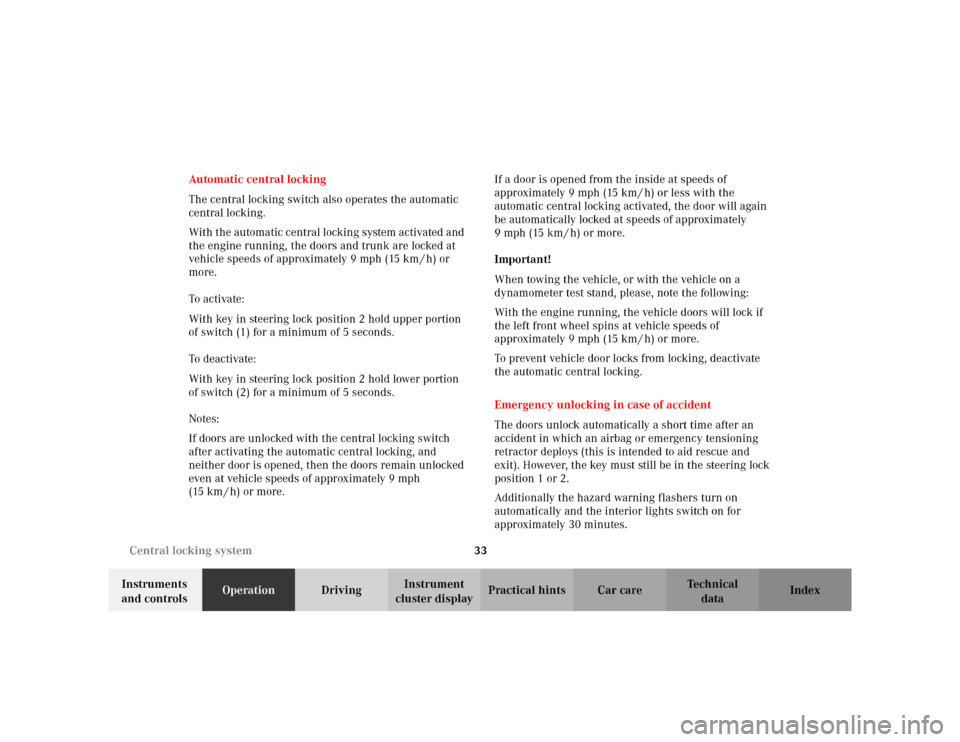
33 Central locking system
Te ch n i c a l
data Instruments
and controlsOperationDrivingInstrument
cluster displayPractical hints Car care Index Automatic central locking
The central locking switch also operates the automatic
central locking.
With the automatic central locking system activated and
the engine running, the doors and trunk are locked at
vehicle speeds of approximately 9 mph (15 km / h) or
more.
To a c ti va te :
With key in steering lock position 2 hold upper portion
of switch (1) for a minimum of 5 seconds.
To deactivate:
With key in steering lock position 2 hold lower portion
of switch (2) for a minimum of 5 seconds.
Notes:
If doors are unlocked with the central locking switch
after activating the automatic central locking, and
neither door is opened, then the doors remain unlocked
even at vehicle speeds of approximately 9 mph
(15 km / h) or more.If a door is opened from the inside at speeds of
approximately 9 mph (15 km / h) or less with the
automatic central locking activated, the door will again
be automatically locked at speeds of approximately
9 mph (15 km / h) or more.
Important!
When towing the vehicle, or with the vehicle on a
dynamometer test stand, please, note the following:
With the engine running, the vehicle doors will lock if
the left front wheel spins at vehicle speeds of
approximately 9 mph (15 km / h) or more.
To prevent vehicle door locks from locking, deactivate
the automatic central locking.
Emergency unlocking in case of accident
The doors unlock automatically a short time after an
accident in which an airbag or emergency tensioning
retractor deploys (this is intended to aid rescue and
exit). However, the key must still be in the steering lock
position 1 or 2.
Additionally the hazard warning flashers turn on
automatically and the interior lights switch on for
approximately 30 minutes.
Page 42 of 342
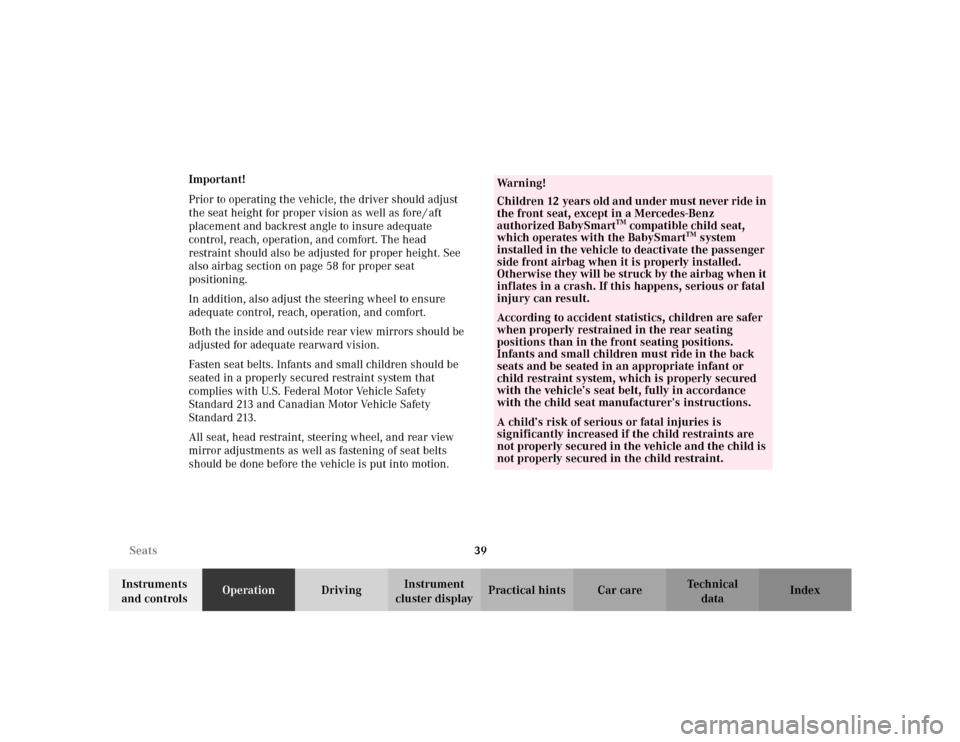
39 Seats
Te ch n i c a l
data Instruments
and controlsOperationDrivingInstrument
cluster displayPractical hints Car care Index Important!
Prior to operating the vehicle, the driver should adjust
the seat height for proper vision as well as fore / aft
placement and backrest angle to insure adequate
control, reach, operation, and comfort. The head
restraint should also be adjusted for proper height. See
also airbag section on page 58 for proper seat
positioning.
In addition, also adjust the steering wheel to ensure
adequate control, reach, operation, and comfort.
Both the inside and outside rear view mirrors should be
adjusted for adequate rearward vision.
Fasten seat belts. Infants and small children should be
seated in a properly secured restraint system that
complies with U.S. Federal Motor Vehicle Safety
Standard 213 and Canadian Motor Vehicle Safety
Standard 213.
All seat, head restraint, steering wheel, and rear view
mirror adjustments as well as fastening of seat belts
should be done before the vehicle is put into motion.
Wa r n i n g !
Children 12 years old and under must never ride in
the front seat, except in a Mercedes-Benz
authorized BabySmart
TM compatible child seat,
which operates with the BabySmart
TM system
installed in the vehicle to deactivate the passenger
side front airbag when it is properly installed.
Otherwise they will be struck by the airbag when it
inflates in a crash. If this happens, serious or fatal
injury can result.
According to accident statistics, children are safer
when properly restrained in the rear seating
positions than in the front seating positions.
Infants and small children must ride in the back
seats and be seated in an appropriate infant or
child restraint system, which is properly secured
with the vehicle’s seat belt, fully in accordance
with the child seat manufacturer’s instructions.A child’s risk of serious or fatal injuries is
significantly increased if the child restraints are
not properly secured in the vehicle and the child is
not properly secured in the child restraint.
Page 43 of 342
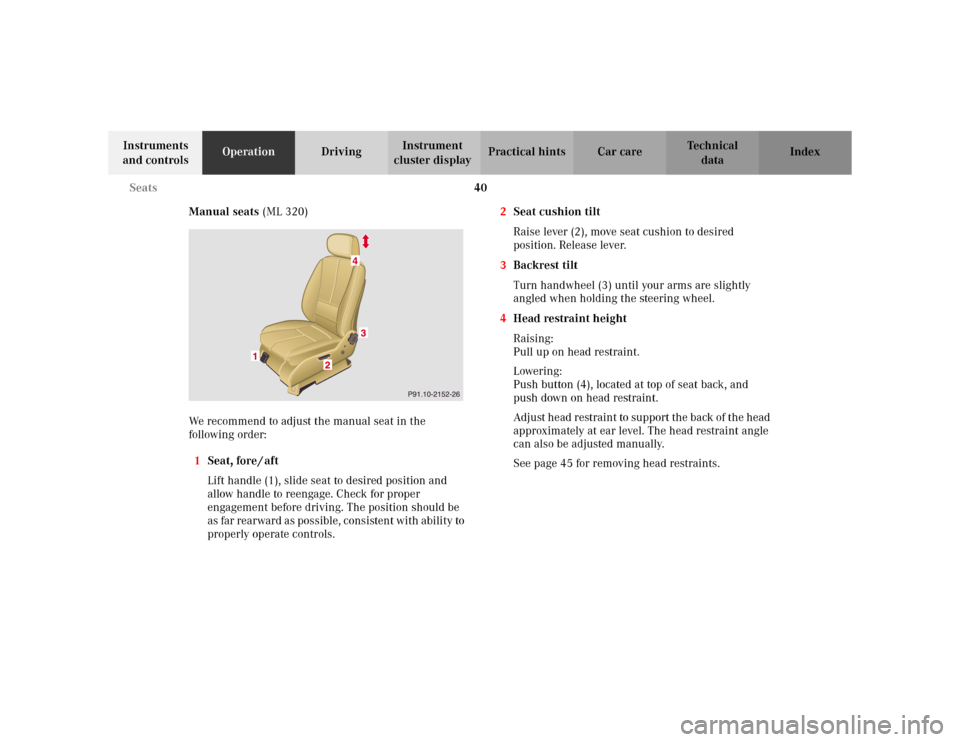
40 Seats
Te ch n i c a l
data Instruments
and controlsOperationDrivingInstrument
cluster displayPractical hints Car care Index
Manual seats (ML 320)
We recommend to adjust the manual seat in the
following order:
1Seat, fore / aft
Lift handle (1), slide seat to desired position and
allow handle to reengage. Check for proper
engagement before driving. The position should be
as far rearward as possible, consistent with ability to
properly operate controls.2Seat cushion tilt
Raise lever (2), move seat cushion to desired
position. Release lever.
3Backrest tilt
Turn handwheel (3) until your arms are slightly
angled when holding the steering wheel.
4Head restraint height
Raising:
Pull up on head restraint.
Lowering:
Push button (4), located at top of seat back, and
push down on head restraint.
Adj ust he ad r estrain t to supp ort the back of t he head
approximately at ear level. The head restraint angle
can also be adjusted manually.
See page 45 for removing head restraints.
Page 44 of 342
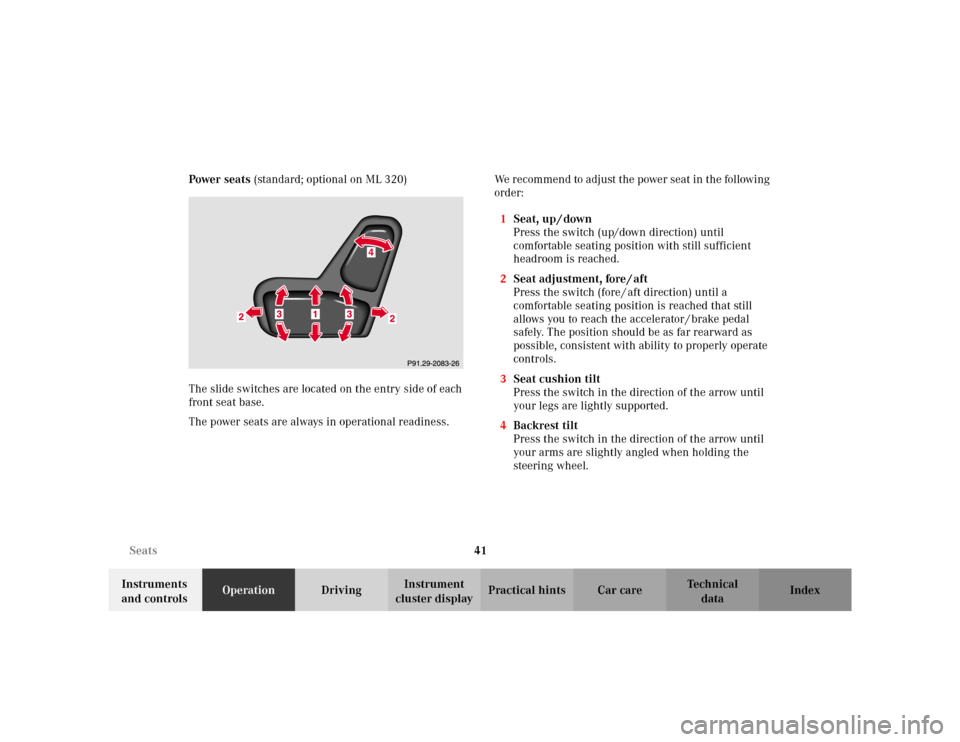
41 Seats
Te ch n i c a l
data Instruments
and controlsOperationDrivingInstrument
cluster displayPractical hints Car care Index Power seats (standard; optional on ML 320)
The slide switches are located on the entry side of each
front seat base.
The power seats are always in operational readiness.We recommend to adjust the power seat in the following
order:
1Seat, up / down
Press the switch (up/down direction) until
comfortable seating position with still sufficient
headroom is reached.
2Seat adjustment, fore / aft
Press the switch (fore / aft direction) until a
comfortable seating position is reached that still
allows you to reach the accelerator / brake pedal
safely. The position should be as far rearward as
possible, consistent with ability to properly operate
controls.
3Seat cushion tilt
Press the switch in the direction of the arrow until
your legs are lightly supported.
4Backrest tilt
Press the switch in the direction of the arrow until
your arms are slightly angled when holding the
steering wheel.
Page 45 of 342
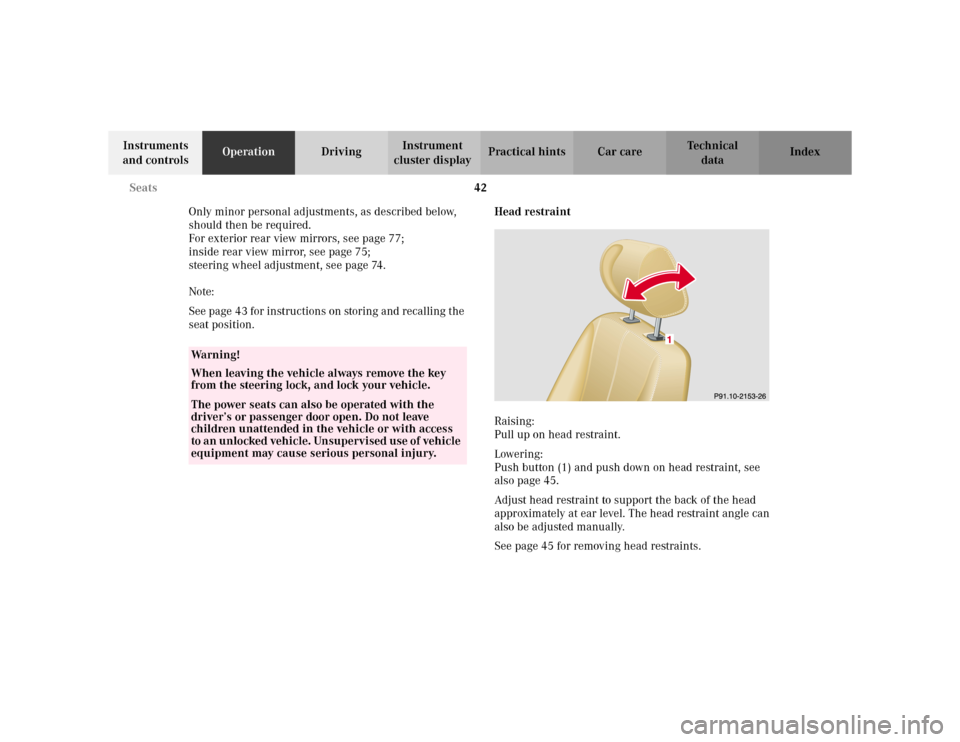
42 Seats
Te ch n i c a l
data Instruments
and controlsOperationDrivingInstrument
cluster displayPractical hints Car care Index
Only minor personal adjustments, as described below,
should then be required.
For exterior rear view mirrors, see page 77;
inside rear view mirror, see page 75;
steering wheel adjustment, see page 74.
Note:
See page 43 for instructions on storing and recalling the
seat position.Head restraint
Raising:
Pull up on head restraint.
Lowering:
Push button (1) and push down on head restraint, see
also page 45.
Adjust head restraint to support the back of the head
approximately at ear level. The head restraint angle can
also be adjusted manually.
See page 45 for removing head restraints.
Wa r n i n g !
When leaving the vehicle always remove the key
from the steering lock, and lock your vehicle.The power seats can also be operated with the
driver’s or passenger door open. Do not leave
children unattended in the vehicle or with access
to an unlocked vehicle. Unsupervised use of vehicle
equipment may cause serious personal injury.